Coin Values Moving with Precious Metals: Up-Dated 11/17/2025: Gold $4066 | Silver $50.70
1950 Penny Value
Follow these steps to 1950 penny value. Combining: Date | Mint Marks | Condition - locates its place on value chart.
Step one. Mint Marks: Small letters were used as part of the design identifying branch mint. Important to value.
Values range across the chart according to condition. Grading condition is detailed with images and descriptions. Matching your coin helps judge grade and place on the chart.
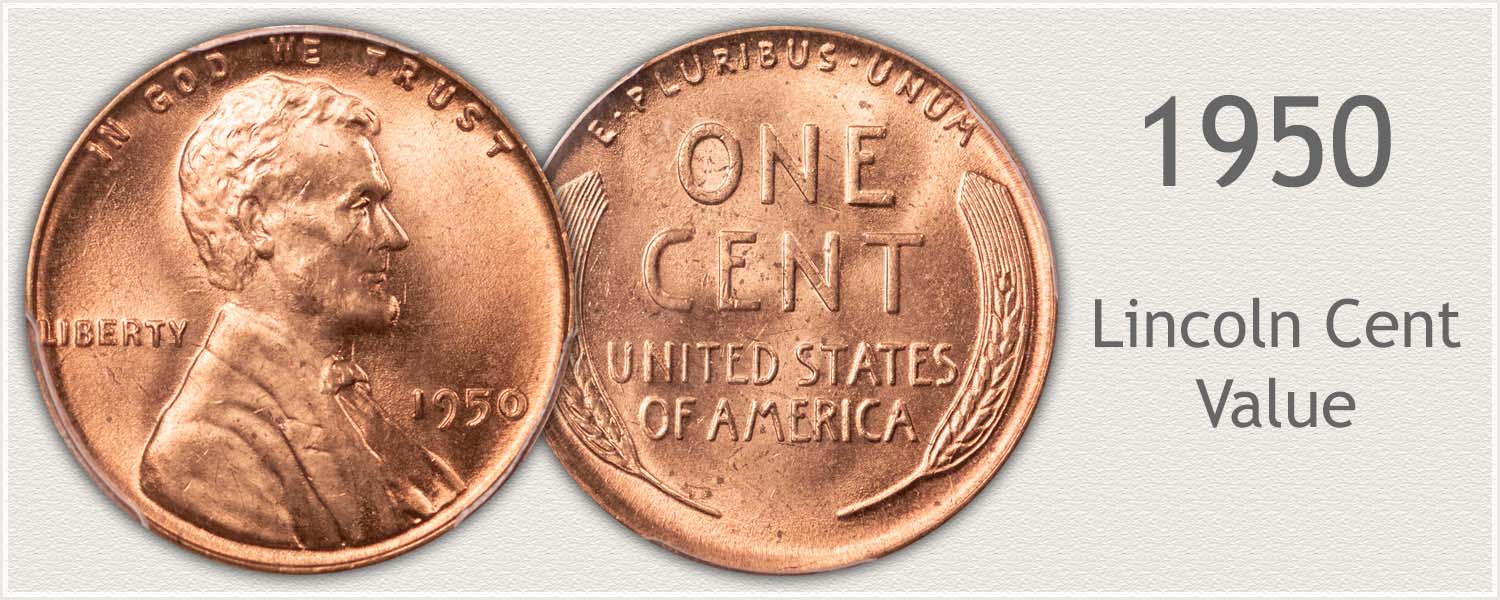
Steps Leading to Value:
- Step 1: Date and Mintmark Variety – Identify each date and its mintmark variety.
- Step 2: Grading Condition – Judge condition to determine grade. Refer to the images to correctly identify the variety of your coin.
- Step 3: Special Qualities – Certain elements either enhance or detract from value.
| 1950 Lincoln Penny Value | ||||
|---|---|---|---|---|
| Condition of Coin | ||||
| Date | Good | Fine | Extremely Fine | Uncirculated |
| 1950 Lincoln Penny Value Up-Dated | 2025 | |||
| 1950 | $0.02 | $0.02 | $0.03 | $2.50 |
| 1950 D | $0.02 | $0.02 | $0.03 | $1.76 |
| 1950 S | $0.02 | $0.03 | $0.04 | $2.08 |
Begin evaluating your coin and finalizing value by confirming its Date: Dates of wheat pennies are a main focus in collecting. Each is unique in scarcity, popularity and desirability.
In 1950 three varieties of cents were produced, struck at the main mint and two branch mints. Mint marks identifying the branch mints further narrow value range.
Next: Complete a Judgement of Condition:
When viewing the chart. Notice condition plays an important role separating average 1950 pennies. Above average examples appeal to collectors. Images in the grading section are used to recognize a close match and complete a value process.
Step 1: | Date and Mintmark Combination
1950 Date and Mint Mark
Three varieties struck, all interesting to collectors. Date and mint combinations are considered individually when placed into a collection of wheat pennies. An available date and popular as an entry to the hobby.
1950 Lincoln Penny
No Mintmark Under Date: Philadelphia Mint Struck the Coin
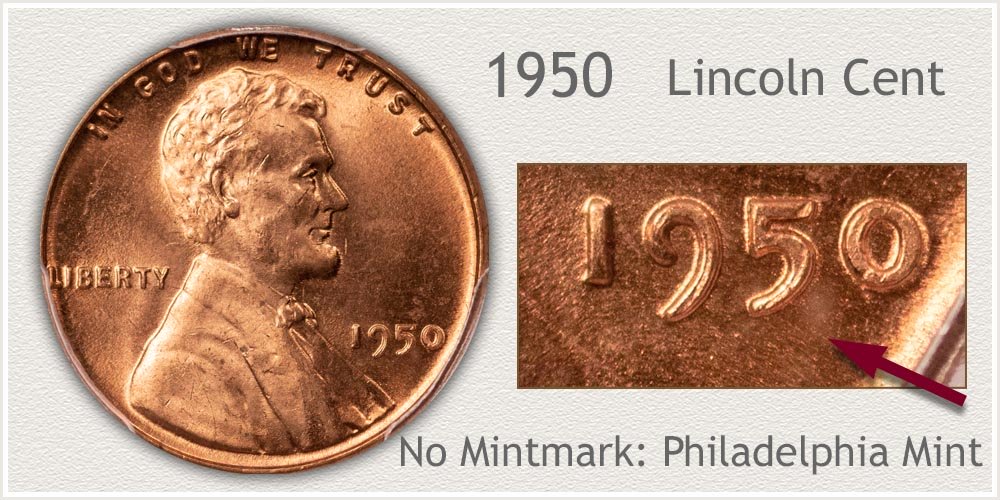
Philadelphia concentrated less on minor denominations in 1950 striking 272,686,386 cents. Adequate to place these as Abundant on a rarity scale. An increase in value and desirability is noted beginning with Extremely Fine condition examples.
A majority of these circulated just long enough to lose a moderated amount of detail to wear. Distinctive areas to inspect are Lincoln's hair and ear, both high in profile. Desirable is a clear, raised separation of his ear from hair.
1950-D Lincoln Penny
"D" Mintmark Under Date: Denver Mint Struck the Coin
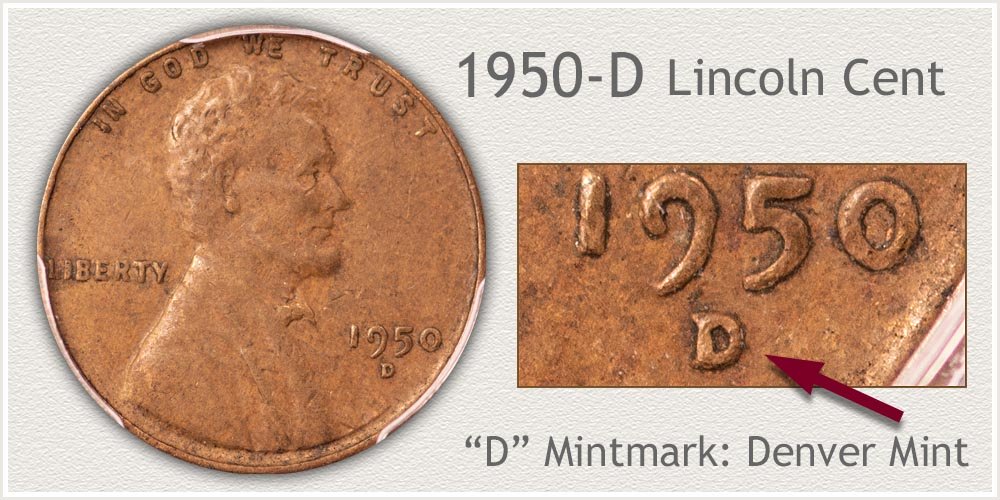
Denver 1950 wheat pennies are Abundant on the rarity scale. 334,950,000 struck, placing 9th highest of all wheat years. Beginning a trend of out pacing the main Philadelphia mint.
In today's market quantities of 1950-D pennies are available. Both in mint state and circulated grades, all are inspected looking for standout examples. Even color is favored over mottled color on mint state examples. Slight wear and sharp definitions to design is sought in circulated pieces.
1950-S Lincoln Penny
"S" Mintmark Under Date: San Francisco Mint Struck the Coin
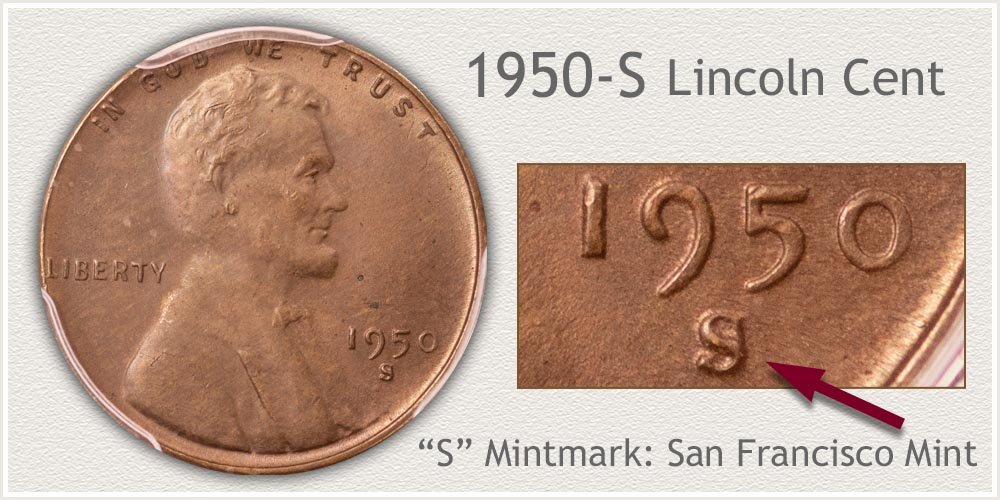
Abundant on the rarity scale, a circulated 1950-S penny enjoys a small premium. Historically San Francisco struck the least of yearly varieties. 118,505,000 in 1950 continued the trend of lowest of year production.
An awareness of low coinage numbers combined with overall popularity is a firm base to value. Interest of collectors is directed towards lightly circulated or finer examples. A pleasing coin is well defined overall. View the reverse, all grains of wheat distinct sets the coin apart.
Step 2: | Judge Condition to Identify Grade
1950 Penny Value is Grade Specific
A "grade" defines the condition of a coin. Specific qualities are inspected as to the amount of wear and compared to the standard for the grade. Key areas are used to judge surface quality. The following images help visualize these differences when judging a wheat cent for condition.
Eye appeal is important to a copper coin and value as a collectible. Overly dark surfaces tend to hide finer detail.
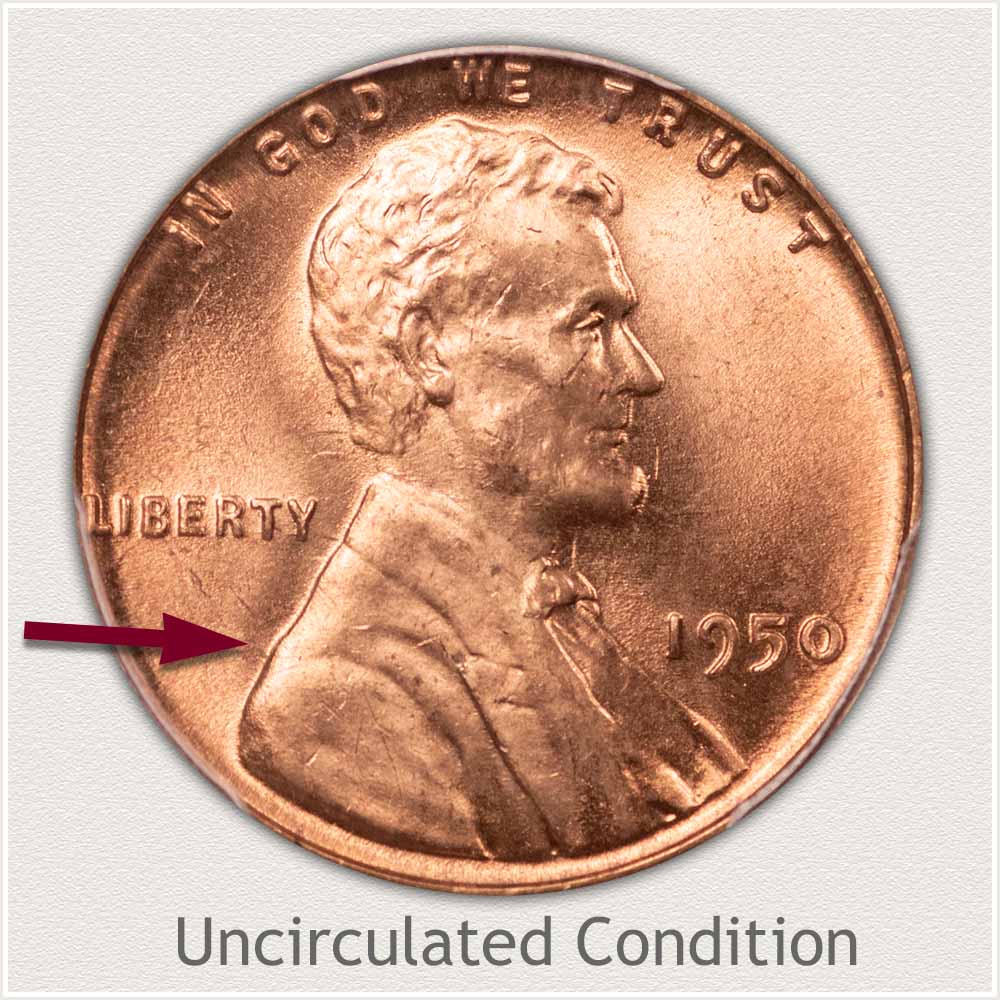
Uncirculated Grade: By the 1950's the dominate collector grade is an uncirculated - mint state grade coin. Large mintage numbers and large saving at the time places these in the abundant category. A key factor in recognizing the mint state condition is no wear to the surface.
Inspect closely the high ridge line at the back of Lincoln. Original fine grain texture causes luster and its delicate nature to wear quickly. Any smoothing of the surface along the shoulder and back indicates wear. Follow the line from Lincoln's collar down to the shoulder looking for a difference in texture.
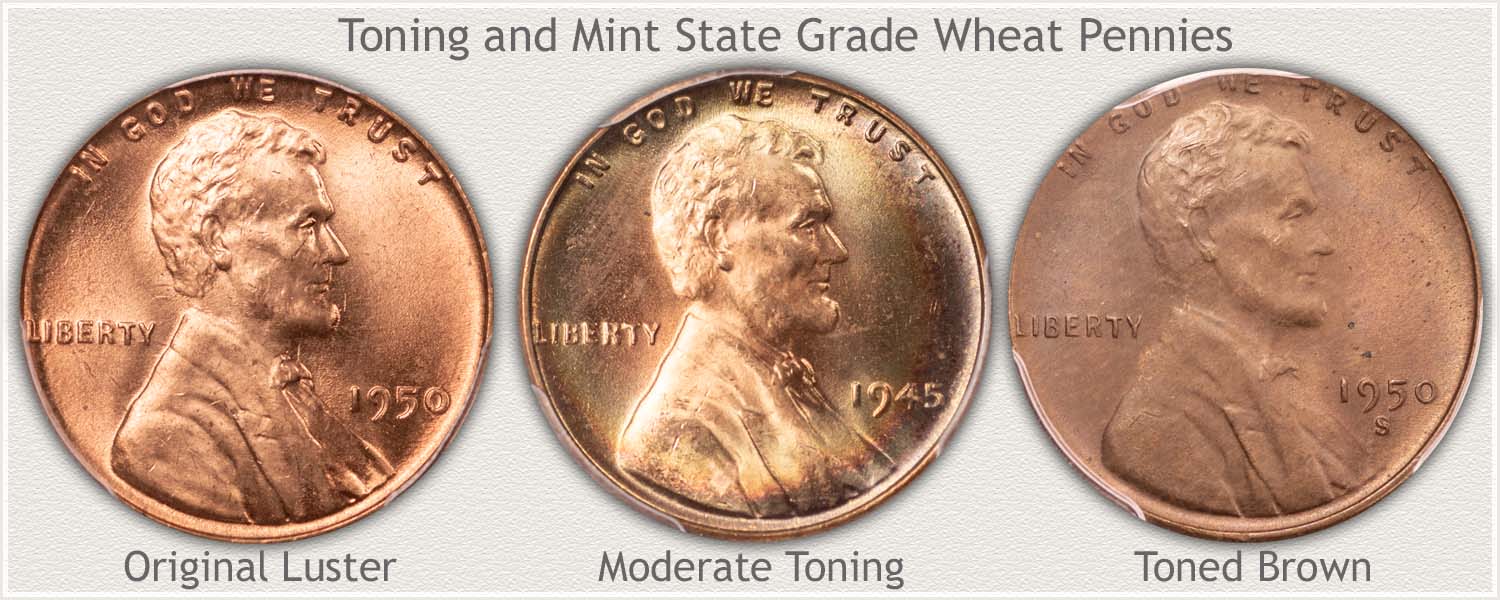
Colors of Uncirculated Grade Wheat Penny: Changes in color of copper is a natural occurrence. This toning begins to develop as a coin is exposed to air. It is not an indication of wear. Often a slight toning lays on the top most surfaces giving a subdued appearance.
Important to a mint state coin is the texture of luster is "underneath" any toning. A magnifying glass and tilting the coin at a sharp angle see to the surface allows to judge for evidence of wear.
The 1950 wheat cent is fully bright with luster. Next is an example starting to tone around the perimeter. At the end is a mint state coin with almost a complete coverage of soft brown toning. As collectibles; values follow these progressions to the toned coin. Highest in demand is a fully bright wheat cent
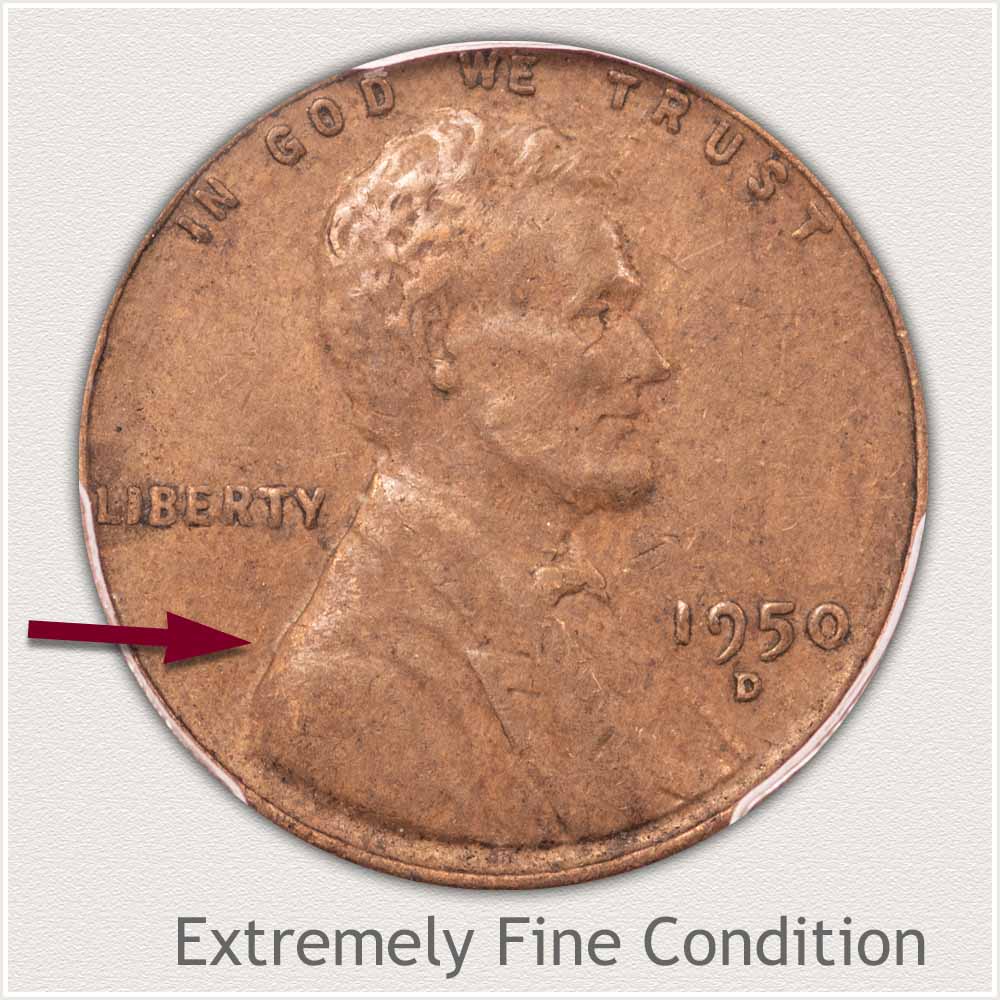
Extremely Fine Grade: Moderate wear, evenly distributed over the surface defines a wheat cent in Extremely Fine grade. The 1950-D penny imaged remains highly detailed, and bold. Only slight wear is evident.
A small degree of smoothing is evident along the coat from Lincoln's collar to the shoulder. Remaining is a distinct lapel and creases depicting the fabric of the coat. It is important to recognize any wear does not form a "flatness" to a rounded profile of the coat rising from the field of the coin.
A nice collectible coin displays soft brown tones, even across the surface. This coin is notable as having no distracting marks and large areas of discoloration. A pleasing, slightly worn wheat cent is a popular, affordable entry to the series. Separate these lightly circulated examples from the rest.
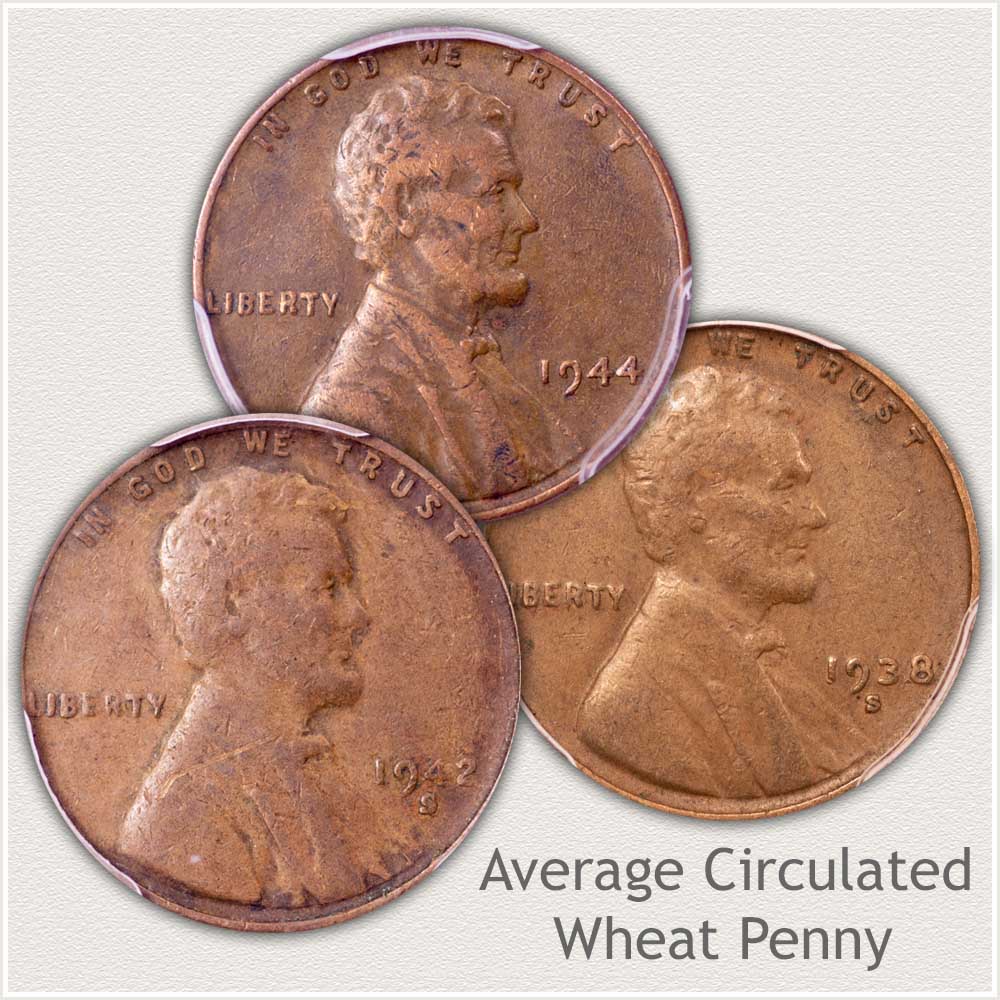
Average Circulated Condition: Saving wheat cents from circulation continued long after the series ended in 1958. Many of the later saves are moderate to heavily worn in condition. These are a large part of the quantities available today.
Moderate condition wheat cents show wear forming flat areas across many features of the coin. Lincoln's cheek, jaw, and hair are flattened and merging with the surroundings. The coins imaged display a typical worn appearance.
An average condition wheat cent forms the base value and condition of the series. Dates in this category are predominate in the 1950's and later 1940's.
Video | Grading Lincoln Wheat Pennies
Grading Lincoln Wheat Pennies covers additional points in greater detail when judging condition. Both the obverse and reverse of these wheat pennies have many areas to examine to help confirm and establish a grade. When grading is complete you are in a position to realize true market value.
Step 3: | Special Qualities Enhancing Value
BIE Cent Popularity and Affordable Value
By the 1950's the Wheat series Lincoln penny was an established collectible. Early years were showing premiums in value and popularity was adding more collectors of the series. With extra eyes now scanning the millions of cents, noticed was the occasional die break within the lettering of "Liberty".
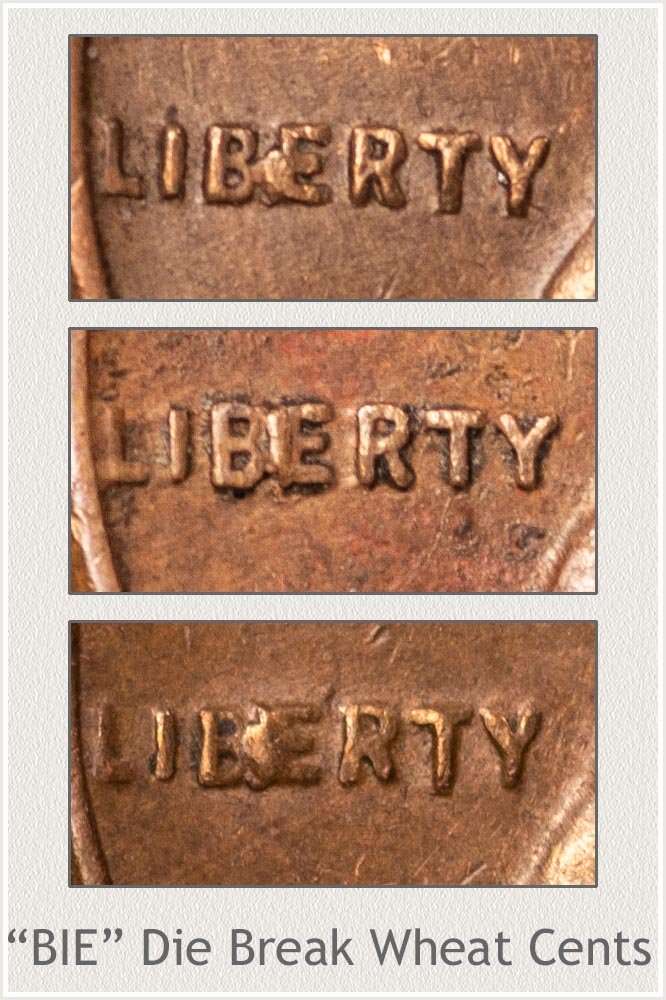
Small sections of the die that create the space between letters, chipped, breaking away. The void left by the broken space filled giving the impression of an extra "I" within the lettering. Often occurring between the "B" and "E" letters, the coins became known as BIE Cents.
These resulting "I's" vary in completeness and aesthetic appeal. The center example in a 1956 wheat cent with a nice representation of the die break. A partial filling and blotchy version are less stunning.
Publicity of BIE cents created a demand in these coins initially with an increase in value. The error was realized as fairly common, with a plentiful supply. Interest in BIE cents cooled and values settled down. Today in most cases they are worth a small premium.
BIE cents are a unique error to the Lincoln cent series only. Set aside any you find. They are a fascination to the series. Notable is the majority of these die breaks are found on coins dated in the 1950's.
ReferencesUS Mint. 1951 US Mint Annual Report https://nnp.wustl.edu/library/publisherdetail/51
Coin Values | CoinStudy Articles
Value chart spans the Wheat design years 1909 through 1958 of Lincoln cents. From uncirculated coins collected by advances collectors to worn examples an affordable collection popular with young collectors. Identify date, mint and condition; a wide range of values is found and identified.
Rare pennies are identified in series from wheat cents back to the early years of the US Mint. These one-cent and half-cents coins first struck in 1793 have a number of stand-out issues.
★ Coin Values Discovery finds 1950 Penny Value and...
US coin value charts covering cents to gold. Identify your coins using the image links. Date | Mintmarks | Condition are described and imaged with each series. Small details necessary to accurately value are described.